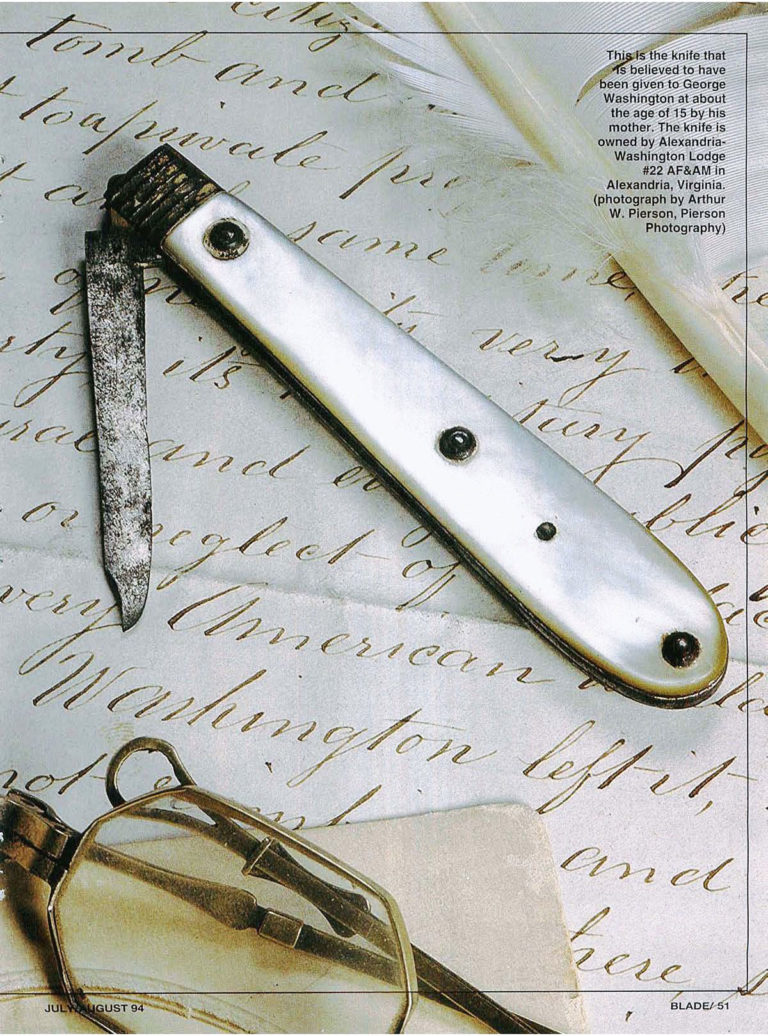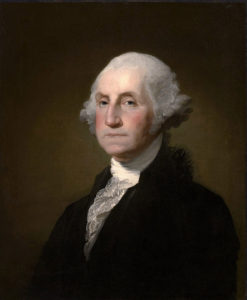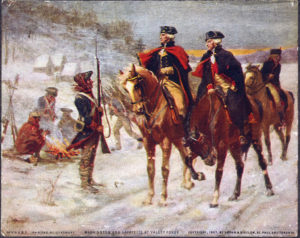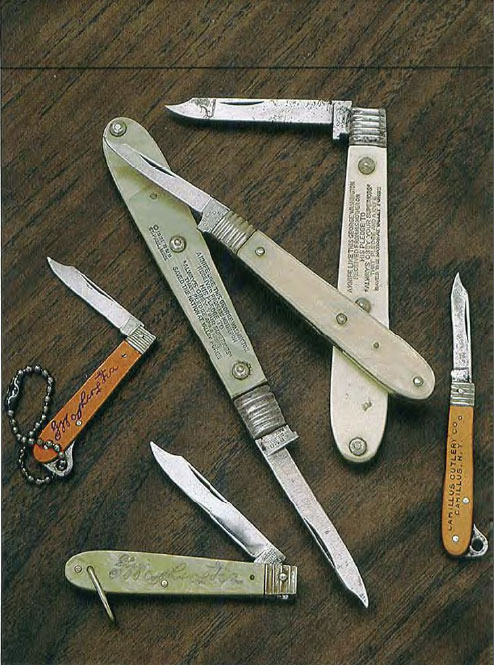
Editor’s note: This article originally appeared in the July/August 1994 issue of BLADE magazine.
Knife History: George Washington’s Penknife
On display at the Alexandria Masonic Lodge in Alexandria, Virginia, is a simple penknife. Its closed length is 3 inches; its handle appears to be mother-of-pearl. the single blade is 1 3/4 inches long.
The claim to fame of this otherwise nondescript cutlery antique is that it was in the possession of George Washington for 56 years. More significant than the knife itself, however, is the story it inspired, a fascinating tale of devotion to duty and strength of character.

Following the death of his father in 1743, a young George Washington, then only 11, went to live with his half-brother, Lawrence. While repairs were being done to the family estate at Mount Vernon, George stayed for a time at Belvoir, the home of William Fairfax, a close friend of the Washington family and also Lawrence’s father-in-law.
“William Fairfax became very fond of George and gave the young man access to his elaborate library,” explained Dr. Claude Harris, archivist of the Alexandria Washington Masonic Lodge, which is located in the George Washington Masonic National Memorial. “Through the influence of his brother and the Fairfax family. George obtained a commission as a midshipman in the [British navy].”
According to Jack Rudell, curator of the replica room of the George Washington Masonic National Memorial, Martha Ball Washington, George’s mother, corresponded with her brother, John Ball, who lived in England.
“John Ball said that the British navy was a floating hell,” commented Rudell. “So [Washington’s mother] was convinced not to let George go.”
Though the details had been worked out and all preparations made, young George respected his mother’s wishes, surrendered his commission and returned to the study of mathematics and surveying.
George’s mother ordered supplies from England annually, and in her next order was a request for one good penknife, which she intended to give to her son as a token of appreciation.
“This she presented to young George as a reward for his submission to her will with the injunction, ‘always obey your superiors,’” remarked Harris. “He carried the token with him through life as a reminder of his mother’s command.”
The Penknife Steps into History

Later, during the Revolutionary War, Washington supposedly recounted the knife’s history in a conversation with one of his most trusted subordinates, Gen. Henry Knox. It was Knox who would later play a key role in Washington’s military future.
As the commander-in-chief quietly deliberated over the situation that bleak winter at Valley Forge, it could scarcely have been more critical. His soldiers were fighting for their very lives against the mightiest military power in the world. If they failed, then along with them would perish an ideal.
“When a timid Congress failed to provide food for his starving and ragged army, in desperation yielding temporarily to his feelings, and in sympathy for his men and disgust with Congress, Washington wrote his resignation as commander-in-chief of the Continental Army and summoned his staff to notify them of his actions,” remarked Harris. “Among the officers present and sitting in the council was Knox, who reminded him of the knife and his mother’s injunction ‘always obey your superiors. You were commanded to lead this army and no one has ordered you to cease leading it.’”
Washington paused and said, “There is something to that. I will think it over.”
Half and hour later he had torn up his resignation, determined to fight to the end. Thus, a penknife may have meant the different between life and death for the USA.
As True as the Cherry Tree Story?

Whether events actually transpired as recorded is as much a matter of opinion as appraisal of fact, but indeed the story of the knife should rank in American folklore with that of the cherry tree and the famous phrase, “I cannot tell a lie.”
Love History and Knives?
Load up on more stories like this one with BLADE‘s collection of back issues. One download gets you 25 years of magazines, all conveniently presented in PDF format.
 NEXT STEP: Download Your Free KNIFE GUIDE Issue of BLADE Magazine
NEXT STEP: Download Your Free KNIFE GUIDE Issue of BLADE Magazine
BLADE’s annual Knife Guide Issue features the newest knives and sharpeners, plus knife and axe reviews, knife sheaths, kit knives and a Knife Industry Directory.Get your FREE digital PDF instant download of the annual Knife Guide. No, really! We will email it to you right now when you subscribe to the BLADE email newsletter.







Thanks for this great information. I have one of the small orange scale penknife keychains from the 1939 New York World’s Fair with the box it came in. It says it’s an official souvenir of the fair. The graphics on the box tell this story of George Washington and his mothers advice. I’ve looked around the web but so far this is the only information and picture of any similar knife.
Mike,
Thanks for the enlightening and entertaining story. Knives hold so many tales of the history of the human endeavour we call life, and swords carry many truths of the struggle for dominance, conquest and freedom. If we are astute enough to see and listen to the stories they can tell. I have one such piece (Japanese) with a tale of forgery and dishonour from 1534. I would like to share this tale and the wisdom it imparts in Blade magazine.